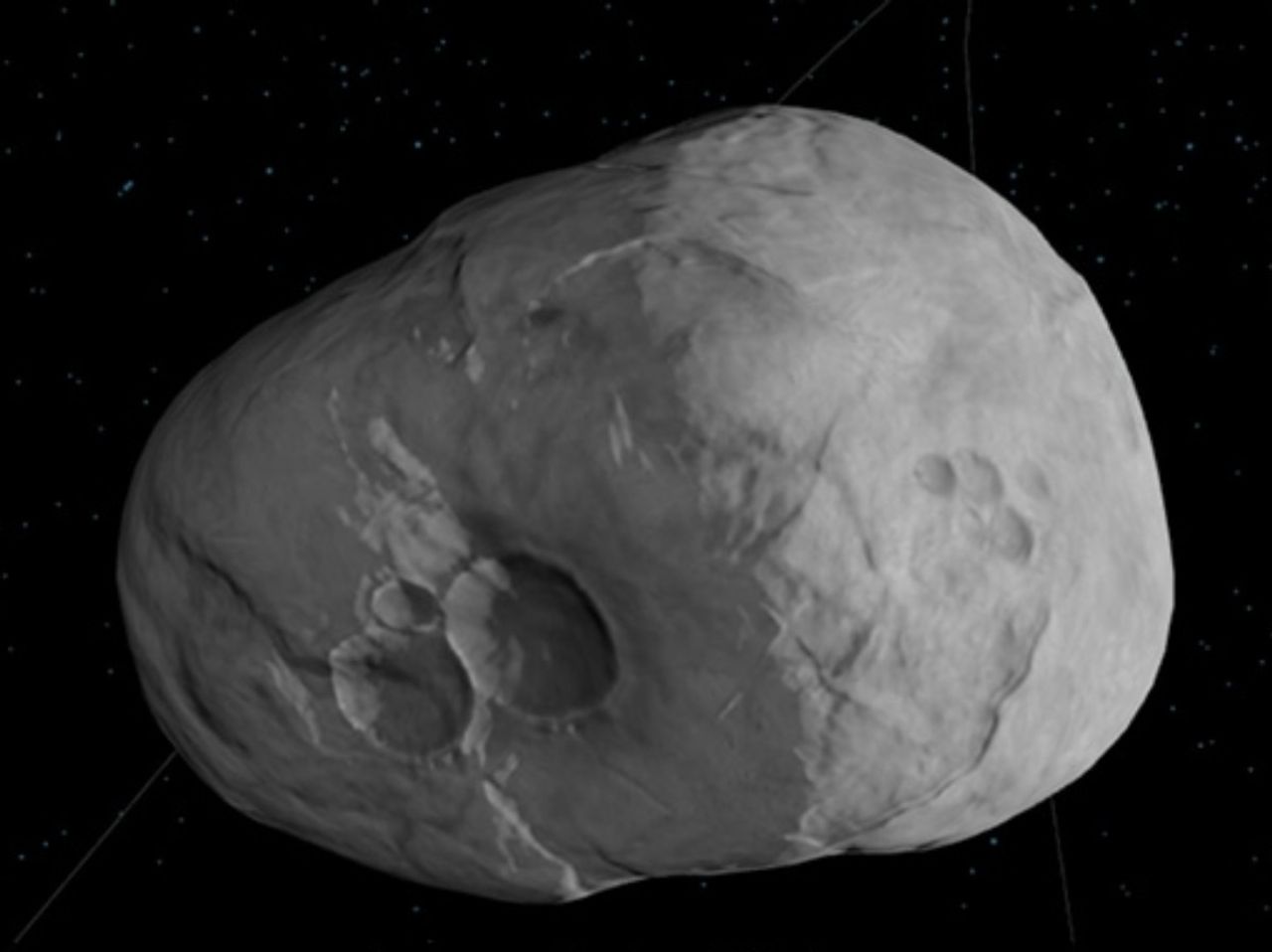Around 4 billion years ago, an asteroid hit the Jupiter moon Ganymede. Now, a Kobe University researcher realized that the Solar System's biggest...
Vous n'êtes pas connecté
- English
- Français
- عربي
- Español
- Deutsch
- Português
- русский язык
- Català
- Italiano
- Nederlands, Vlaams
- Norsk
- فارسی
- বাংলা
- اردو
- Azərbaycan dili
- Bahasa Indonesia
- Հայերեն
- Ελληνικά
- Bosanski jezik
- українська мова
- Íslenska
- Türkmen, Түркмен
- Türkçe
- Shqip
- Eesti keel
- magyar
- Қазақ тілі
- Kalaallisut ; kalaallit oqaasii
- Lietuvių kalba
- Latviešu valoda
- македонски јазик
- Монгол
- Bahasa Melayu ; بهاس ملايو
- ဗမာစာ
- Slovenščina
- тоҷикӣ ; toğikī ; تاجیکی
- ไทย
- O'zbek ; Ўзбек ; أۇزبېك
- Tiếng Việt
- ភាសាខ្មែរ
- རྫོང་ཁ
- Soomaaliga ; af Soomaali
Rubriques :
 Maroc - RAWSTORY.COM - Raw Story - 03/Sep 10:49
Maroc - RAWSTORY.COM - Raw Story - 03/Sep 10:49
Meet Phaethon, a weird asteroid that thinks it’s a comet
What’s the difference between an asteroid and a comet? A comet is basically a dirty iceball composed of rock and ice. The classic image is of a bright “star” in the night sky with a long curved tail extending into space. This is what happens when they approach the Sun and start emitting gases and releasing dust. It normally continues until there’s nothing left but rock or until they fragment into dust. Asteroids, on the other hand, are primarily just rocks. They might conjure up notions of Hans Solo steering the Millennium Falcon through an implausibly dense “asteroid field” to escape a swarm of TIE Fighters, but mostly they just quietly orbit the Sun, minding their own business. Yet these two space objects are not always as mutually exclusive as this would suggest. Let me introduce Phaethon, a “rock comet” that blurs the definitions between asteroid and comet, and let me tell you why it will be worth paying attention to this fascinating object in the coming years. Phaethon was discovered by chance in 1983 by two astronomers at the University of Leicester, Simon Green and John Davies. They came across it orbiting the Sun while analysing images collected by a space telescope called the Infrared Astronomical Satellite (Iras). Soon after, other astronomers recognised that Phaethon is the source of the annual Geminid meteor shower – one of the brightest meteor displays in Earth’s calendar. Every December, as our planet crosses the dusty trail left behind by Phaethon, we are treated to a brilliant spectacle as its dust grains burn up in our atmosphere. Yet Phaethon’s behaviour is unlike that of any other objects responsible for a meteor shower.Unlike typical comets that shed substantial amounts of dust when they heat up near the Sun, Phaethon doesn’t seem to be releasing enough dust today to account for the Geminids. This absence of significant dust emissions generates an interesting problem.Phaethon’s orbit brings it extremely close to the Sun, much closer than Mercury, our innermost planet. At its closest approach (termed perihelion), its surface temperature reaches extremes of around 730°C. You would expect such intense heat to strip away any volatile materials that exist on Phaethon’s surface. This should either expose fresh, unheated layers and shed huge volumes of dust and gas each time it passes close to the Sun, or form a barren crust that protects the volatile-rich interior from further heating, leading to an absence of gas or dust release. Neither of these processes seem to be occurring, however. Instead, Phaethon continues to exhibit comet-like activity, emitting gas but not an accompanying dust cloud. It’s therefore not shedding layers, so the mystery is why the same crust can still emit volatile gases each time it is heated by the Sun. Our experimentI led newly published research aimed at addressing this puzzle by simulating the intense solar heating that Phaethon experiences during its perihelion. We used chips from a rare group of meteorites called the CM chondrites, which contain clays that are believed to be similar to Phaethon’s composition. These were heated in an oxygen-free environment multiple times, simulating the hot-cold/day-night cycles that occur on Phaethon when it is close to the Sun.The results were surprising. Unlike other volatile substances that would typically be lost after a few heating cycles, the small quantities of sulfurous gases contained in the meteorites were released slowly, over many cycles. This suggests that even after numerous close passes by the Sun, Phaethon still has enough gas to generate comet-like activity during each perihelion.But how might this work? Our theory is that when Phaethon’s surface heats up, iron sulphide minerals held in its subsurface break down into gases, such as sulphur dioxide. However, because the surface layers of Phaethon are relatively impermeable, these gases cannot escape quickly. Instead, they accumulate beneath the surface, for example in pore spaces and cracks. As Phaethon rotates, which takes just under four hours, day turns to night and the subsurface cools. Some of the trapped gases are able to “back-react” to form a new generation of compounds. When night turns to day again and heating restarts, these decompose and the cycle repeats. Why this mattersThese findings are not just academic but have implications for the Japanese Space Agency (Jaxa)‘s Destiny+ mission, set to launch later this decade. This space probe will fly past Phaethon and study it using two multispectral cameras and a dust analyzer. It will hopefully gather particles that will provide further clues about the composition of this enigmatic object. How Destiny+ will visit Phaethon:Either way, our research team’s theory of Phaethon’s gas-emission processes will be crucial for interpreting the data. If we are proven right, it will redefine how scientists think about solar heating as a geological process by making it relevant not only to comets but also to asteroids. Crucially, Phaethon is not alone. There are about 95 asteroids that pass within 0.20 astronomical units (nearly 19 million miles) of the Sun. Whatever we learn from Phaethon could offer insights into their behaviour and long-term stability, too. Finally, you may be wondering how all this relates to the Geminid meteor shower. Most likely, Phaethon was emitting dust many years ago. This would have produced the debris band that creates the Geminid shower each time the particles come into contact with Earth’s atmosphere. When we talk about gifts that keep on giving, it’s hard to think of a better example.Martin D. Suttle, Lecturer in Planetary Science, The Open UniversityThis article is republished from The Conversation under a Creative Commons license. Read the original article.
Articles similaires
ISRO Warns of 'Worst Case Scenario' as Large Asteroid Approaches Earth
In an announcement that has captured the attention of scientists and space enthusiasts alike, the Indian Space Research Organisation (ISRO) has issued...
ISRO Warns of 'Worst Case Scenario' as Large Asteroid Approaches Earth
In an announcement that has captured the attention of scientists and space enthusiasts alike, the Indian Space Research Organisation (ISRO) has issued...
Earth To Get Another Moon Temporarily For 56 Days : Report
Earth might gain another Moon, a miniature one, due to a rare phenomenon called gravitational trapping. Carlos de la Fuente Marcos and Raúl de la...
Early Earth May Have Had Rings Like Saturn
Saturn, Neptune, Uranus and Jupiter are the four planets in the solar system that have rings. Saturn has the most prominent rings as they formed after...
Early Earth May Have Had Rings Like Saturn
Saturn, Neptune, Uranus and Jupiter are the four planets in the solar system that have rings. Saturn has the most prominent rings as they formed after...
The sun bubbles. Astronomers just saw a distant star do it, too.
Each bubble is 75 times the size of the sun. Like an enormous lava lamp, the sun roils with hot bubbles that rise from its belly to the surface, then...
Ships symbols of our journey
THE EDITOR: The three ships on our coat of arms symbolise the arrival of Christopher Columbus in Trinidad in 1498. While acknowledging the...
We’re Closer Than Ever To Solving Mystery Of Deadly Virus
Around 58 million people suffer from chronic inflammation caused by the hepatitis C virus, and 300,000 people die from the disease every year. So...
Restoring the sense of belonging and purpose
Sense of belonging, as I have mentioned in a past article, What it means to be Bhutanese?- is our authentic connection to our common heritage, our...
Les derniers communiqués
-
Adobe Brings Conversational AI to Trillions of PDFs with the New AI Assistant in Reader and Acrobat
Adobe - 21/02/2024
-
Laura Frigenti takes the Helm as Chief Executive Officer of the Global Partnership for Education
Global Partnership for Education - 05/12/2022





